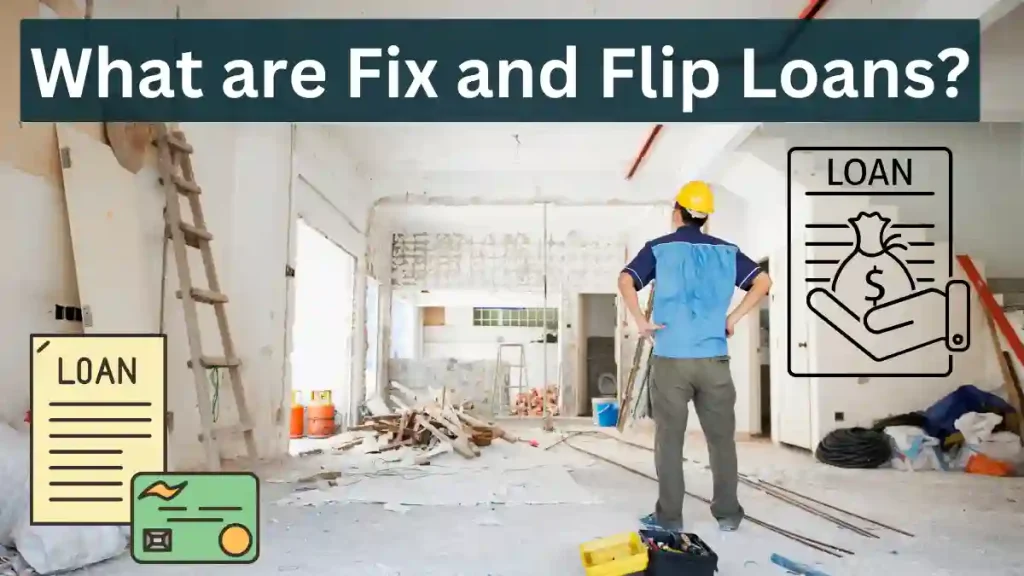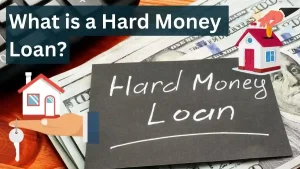Have you ever dreamed of making a quick profit by flipping a house?
If so, you’re not alone. Fix and flip loans have become increasingly popular in recent years, as they offer real estate investors a way to access the capital they need to purchase and renovate properties, and then sell them for a profit.
But before you jump into the world of fix and flip loans, it’s important to understand how they work and what the risks and rewards are.
In this blog post, we’ll cover everything you need to know about fix and flip loans, including how to qualify, how to get approved, and how to use them to maximize your profits.

What are Fix and Flip Loans?
Fix and flip loans is a short-term loans that real estate investors use to purchase and renovate a property in order to resell it for a profit.
These loans are typically secured by the property itself, and lenders will typically lend up to 90% of the purchase price and renovation costs, not to exceed 85% of the after-repair value (ARV) of the property.
Fix and flip loans can be a great way for real estate investors to generate quick profits, but they are also a risky investment. If the investor is unable to sell the property for a profit and unable to repay the loan they may be left with a significant financial loss. Also, if the investor (borrower) defaults on the loan, their property might be seized by the lenders.
Note: ARV (After-Repair Value) in real estate is the estimated value of a property after completed renovations and not in its current condition.
How do Fix and Flip Loans Work?
Once a real estate investor has found a property that they believe has the potential to be flipped for a profit, they will need to secure a fix and flip loan. This process typically involves submitting a loan application to a lender, along with supporting documentation such as proof of income, credit score, and business plan.
This business plan should include information such as the purchase price of the property, the renovation costs, the estimated ARV of the property, and your timeline for selling the property.
If the loan is approved, the lender will fund the purchase price of the property and the renovation costs.
The investor will then be responsible for making monthly interest payments on the loan until the property is sold. Once the property is sold, the investor will use the proceeds to repay the loan in full, plus any interest that has accrued.
Benefits of Using Fix and Flip Loans
There are a number of benefits to using fix and flip loans, including:
- Access to Capital: Fix and flip loans can provide investors with the capital they need to purchase and renovate a property, even if they do not have a lot of cash on hand.
- Flexible Terms: Fix and flip loans typically have more flexible terms than traditional mortgages, such as shorter repayment periods and higher interest rates. This can be beneficial for investors who need to sell their property quickly in order to maximize their profits.
- Tax Benefits: Investors can deduct the interest they pay on fix and flip loans from their taxable income. This can definitely help to reduce their overall tax burden.
Types of Fix and Flip Loans
There are two main types of fix and flip loans: Hard Money Loans and Traditional Bank Loans.
- Hard Money Loans: Hard Money Loan is a short-term, high-interest, secured loan (by real property) that is typically used by real estate investors who need to finance a property purchase or renovation. They are often funded by private investors and can be approved quickly, even if you have bad credit.
- Traditional Bank Loans: Traditional bank loans typically have lower interest rates than hard money loans, but they can be more difficult to qualify for and may take longer to approve.

In addition to these two main types of loans, there are a few other types of fix and flip loans available, such as:
- Rehab Loans: Rehab loans are similar to traditional bank loans, but they are specifically designed for borrowers who are renovating a property. Rehab loans typically have a higher loan-to-value ratio than traditional bank loans, meaning that you can borrow up to 90% of the purchase price and renovation costs of the property.
- Bridge Loans: Bridge loans are short-term loans that can be used to gap the time between the purchase of a property and the sale of another property. Bridge loans are typically used by investors who are selling one property to buy another property.
- Private Equity Loans: Private equity loans are loans from private investors. Private equity lenders typically look for borrowers with a good track record of success and a solid business plan.
Which type of Fix and Flip Loan is Right for you?
The best type of fix and flip loan for you will depend on your individual circumstances. If you have good credit and are willing to wait longer for approval, a traditional bank loan may be the best option for you. But if you need money quickly or have bad credit, a hard money loan may be a better option.
It is important to shop around and compare offers from multiple lenders before you choose a fix and flip loan. Be sure to read the fine print carefully and understand the loan terms before you sign anything.
Who Should Consider Using Fix and Flip Loans?
Fix and flip loans are a good option for experienced real estate investors who have a good understanding of the market and the renovation process. These loans can also be a good option for investors who are looking to start or grow their real estate investment business.
However, it is important to note that fix and flip loans can be risky. If the investor/borrower is unable to sell the property for a profit, they may be left with a significant financial loss. Also, if they can’t pay back the loan or default on the loan, the lender can foreclose on the property and sell it to recover their losses.
How to get a Fix and Flip Loan?
To get a fix and flip loan, you will need to:
- Find a lender. There are a number of different types of lenders that offer fix and flip loans, including hard money lenders, traditional banks, and private equity lenders.
- Get pre-approved for a loan. Getting a pre-approved for loan will give you an idea of how much money you can borrow and what your monthly payments will be.
- Find a property to flip. Once you are pre-approved for a loan, you can start looking for properties to flip. Be sure to choose a property that has the potential to be flipped for a profit.
- Submit a loan application. Once you have found a property, you will need to submit a loan application to the lender. The loan application will typically require you to provide information such as your contact information, income, credit score, and the property you are interested in flipping.
- Provide the lender with a business plan. The lender will want to see a detailed business plan for your flip. This business plan should include information such as the property’s purchase price, the renovation costs, the estimated ARV, and your timeline for selling the property.
- Close on the loan. Once your loan is approved, you will need to close on the loan. This process typically involves signing paperwork and providing the lender with the down payment.
How to Qualify for a Fix and Flip Loan?
The qualifications for a fix and flip loan will vary depending on the lender. Nevertheless, most lenders will require the following:
- A Good Credit Score
- A Strong Down Payment
- Experience with Real Estate Investing
- A detailed Business Plan for the flip
Here are a few tips for getting approved for a fix and flip loan:
- Have a Good Credit Score. A good credit score will show the lender that you are a responsible borrower and that you are likely to repay the loan.
- Make a Large Down Payment. A larger down payment will reduce the amount of money you need to borrow and make you a more attractive borrower to the lender.
- Have a Solid Business Plan. The lender will want to see a detailed business plan for your flip. This business plan should show the lender that you have a good understanding of the market and that you are likely to be successful in your flip.
It is important to note that fix and flip loans can be risky. If you are unable to sell the property for a profit, you may be left with a significant financial loss.
How to Apply for a Fix and Flip Loan?
To apply for a fix and flip loan, you will need to submit a loan application to a lender. The loan application will typically require you to provide information such as your contact information, income, credit score, and the property you are interested in flipping.
You will also need to provide the lender with a business plan for your flip. This business plan should include information such as the purchase price of the property, the renovation costs, the estimated ARV of the property, and your timeline for selling the property.
Tips for Getting the Best Interest Rates on a Fix and Flip Loan
Here are a few tips for getting the best interest rates on a fix and flip loan:
- Shop around Multiple lenders and compare their offers.
- Make a large down payment.
- Have a good credit score.
- Provide the lender with a detailed business plan for your flip.
How to Use a Fix and Flip Loan to Maximize Your Profits?
Here are a few tips for using a fix and flip loan to maximize your profits:
1. Buy the right property
Choose a property that is located in a desirable area and that has the potential to be flipped for a profit. Consider factors such as the condition of the property, the need for repairs, and the current market value of similar properties in the area.
2. Renovation wisely
Focus on making renovations that will increase the value of the property, but avoid overspending on unnecessary upgrades. Common renovations that can add value to a property include updating the kitchen and bathrooms, painting the interior and exterior, and making minor repairs.
3. Sell the property quickly
The longer you hold onto the property, the more interest you will accrue on your loan. Have a plan in place to market the property and sell it quickly once the renovations are complete.
Fix and Flip Loans for Beginners
If you are a beginner real estate investor, there are a few things you should keep in mind before using a fix and flip loan:
- Do your research: Make sure you understand the risks and rewards of fix and flip investing before you get started. Just because you see the hefty profits right away, don’t just jump into the real estate flipping business right away.
- Start with a small project: Don’t try to flip your dream home right away. Start with a smaller, less expensive property.
- Get help from a mentor: Find an experienced real estate investor who can mentor you and help you avoid making costly mistakes.
- Be prepared for unexpected expenses: Things don’t always go according to your plan when renovating a property. Be prepared to face unexpected expenses and have a backup plan in place.
Fix and Flip Loans with Bad Credit
If you have bad credit, it may still be possible to qualify for a fix and flip loan.
However, you will likely need to pay a higher interest rate and make a larger down payment.
There are a few lenders that specialize in making fix and flip loans to borrowers with bad credit. You can also consider partnering with a real estate investor who has good credit.
Fix and Flip Loans for Beginners with Bad Credit
If you are a beginner real estate investor with bad credit, it is important to be very careful when considering a fix and flip loan. The risks are even higher for investors with bad credit, so it is essential to do your research and make sure you understand the terms of the loan before you sign anything.
Here are a few things to keep in mind:
- Shop around and compare offers from multiple lenders. Get pre-approved for a loan before you start looking for properties. This will give you an idea of what you can afford and what your monthly payments will be.
- Choose a property that has a lot of equity. This will give you some cushion in case the renovations cost more than expected or the market takes a downturn.
- Make a large down payment. This will reduce the amount of money you need to borrow and lower your monthly payments.
- Have a detailed business plan. This will help you stay on track and budget for the project.
- Be prepared for unexpected expenses. Things don’t always go according to plan when renovating a property. Be prepared to face unexpected expenses and have a backup plan in place.
Conclusion: Is Fix and Flip Loan Worth it?
Fix and flip loans can be a great way for real estate investors to generate quick profits. However, it is important to understand the risks and rewards before you consider taking out a loan. If you are a beginner investor, it is important to start small and get help from a mentor.
Yes, it is definitely worth it given that you know your A-Game!
Best Options for Fix and Flip Loans
#1. New Silver Loan

New Silver Loan is a US-based fintech company founded in 2018 that provides fast and easy financing to real estate investors.
They specialize in fix-and-flip loans but also offer loans for other types of real estate investments, such as rental properties and development projects.
They use software that accelerates, automates, and streamlines loan origination while using data to reduce the risk of loan default.


